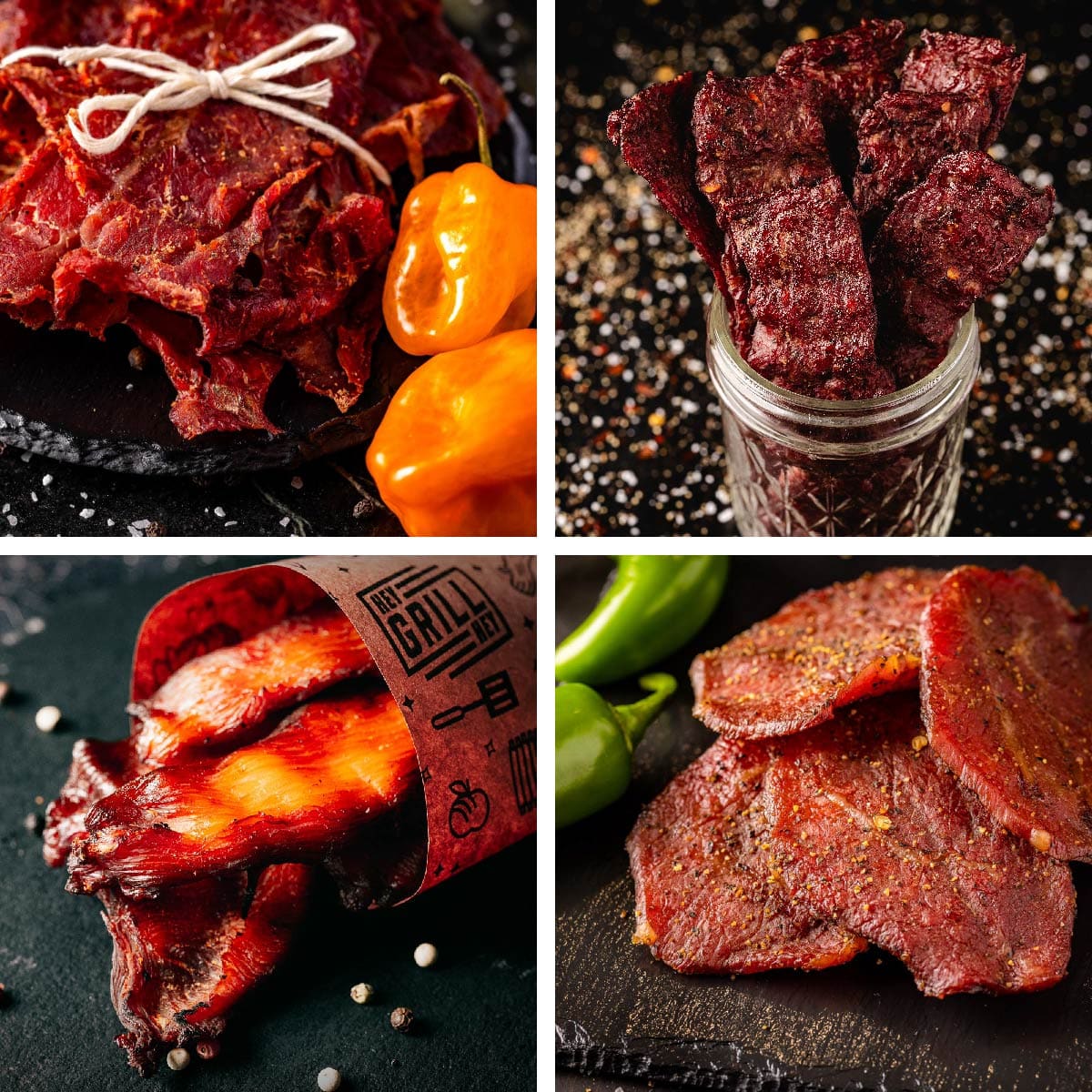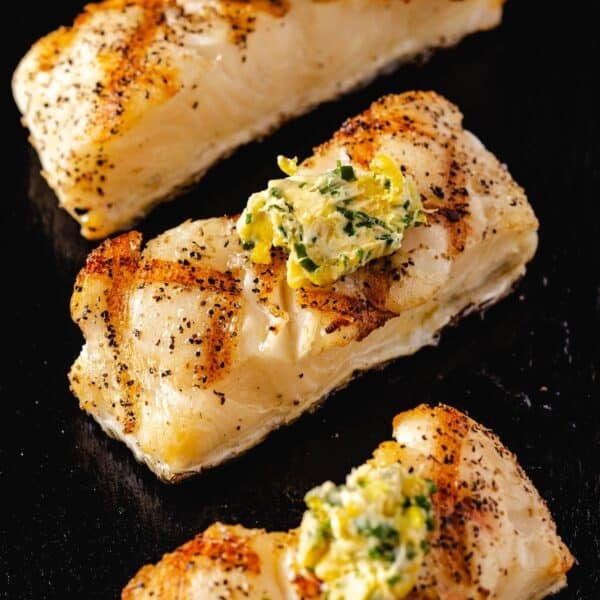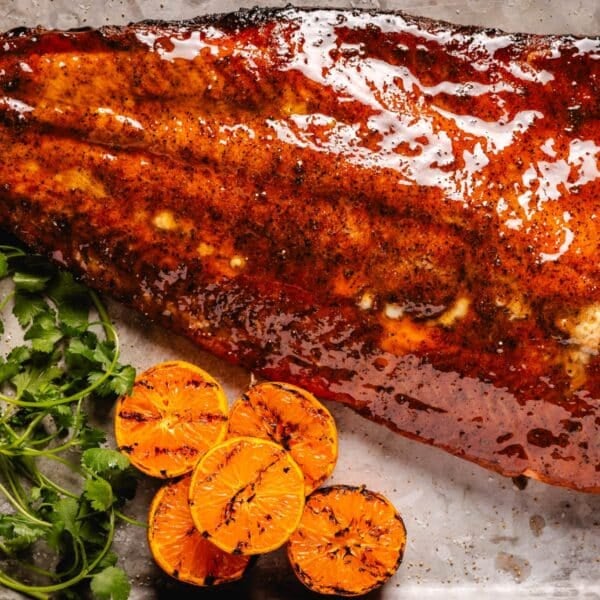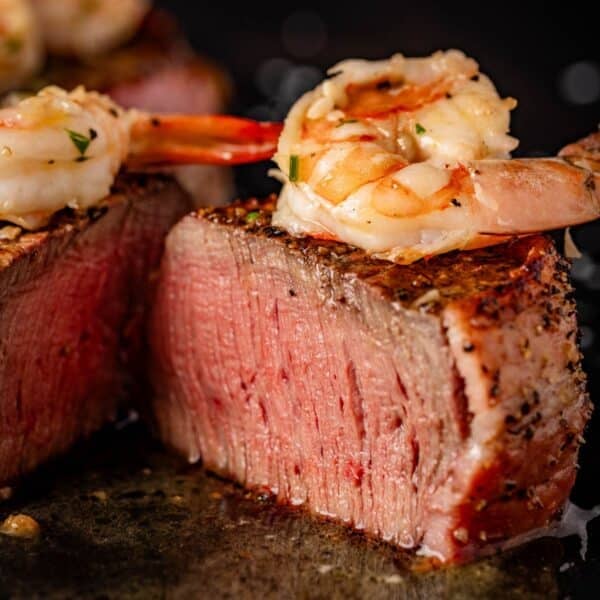Smoked Steelhead Trout
On November 15, 2024
This post may contain affiliate links. Please read our disclosure policy.
This Smoked Steelhead trout soaks in a brown sugar brine before smoking slow to flaky perfection, and finished with a maple bourbon glaze.

Smoked Steelhead Trout with Maple Bourbon Glaze
There’s something magical about smoking fish, and this Smoked Steelhead Trout with Maple Bourbon Glaze is one of my absolute favorites. The flesh turns out perfectly tender and flaky, with just the right balance of smoke, sweetness, and that natural buttery flavor that steelhead is known for. I love serving this as a crowd-pleasing main course for special occasions, but it’s simple enough for a weeknight dinner your family will love. The maple bourbon glaze adds this incredible caramelized finish that’ll have everyone coming back for seconds, and thirds.
Steelhead Trout vs Salmon
Steelhead trout and salmon look pretty similar, they’re actually different fish with their own unique characteristics. Like salmon, steelhead trout does spend time in both freshwater and the sea, so they share that gorgeous, orange-pink color and buttery flavor. Trout tends to have a milder, less “fishy” flavor than salmon, but a little more intense than you’ll find in rainbow trout, which only live in freshwater. If you’ve tried my Smoked Salmon with Maple Orange Glaze or my Smoked Trout recipe (which uses rainbow trout), you’ll notice steelhead is somewhere between the two when it comes to flavor intensity. It’s prefect for guests who like a little fish flavor, but don’t want it to overpower their tongue.

Brine for Smoked Trout
A good brine is your secret weapon for tender smoked fish, and I’ve kept this one super simple but effective. This basic mixture helps the fish retain moisture during smoking while enhancing its natural flavors.
- Kosher salt: The salt does more than just season. It helps create a flaky texture by breaking down some of the muscle. It also helps the fish hold onto moisture during the smoking process. This means you’ll end up with juicy, tender fish instead of dry, tough fillets.
- Brown sugar: The sugar balances out the salt and helps create that beautiful mahogany color on the outside of the fish. It also helps keep your fish moist and adds a subtle sweetness that blends perfectly with the smoke flavor.
- Cool water: You want to use cool water to keep the fish food-safe during brining. Warm water can lead to bacteria, and nobody wants that. The water also helps distribute the salt and sugar evenly throughout the fish.
I only brine my steelhead for about 15 minutes. This gives the brine just enough time to work its magic without overwhelming the delicate fish. If you’re feeling adventurous, you can try my Smoked Salmon Brine, which adds some citrus notes to the mix.
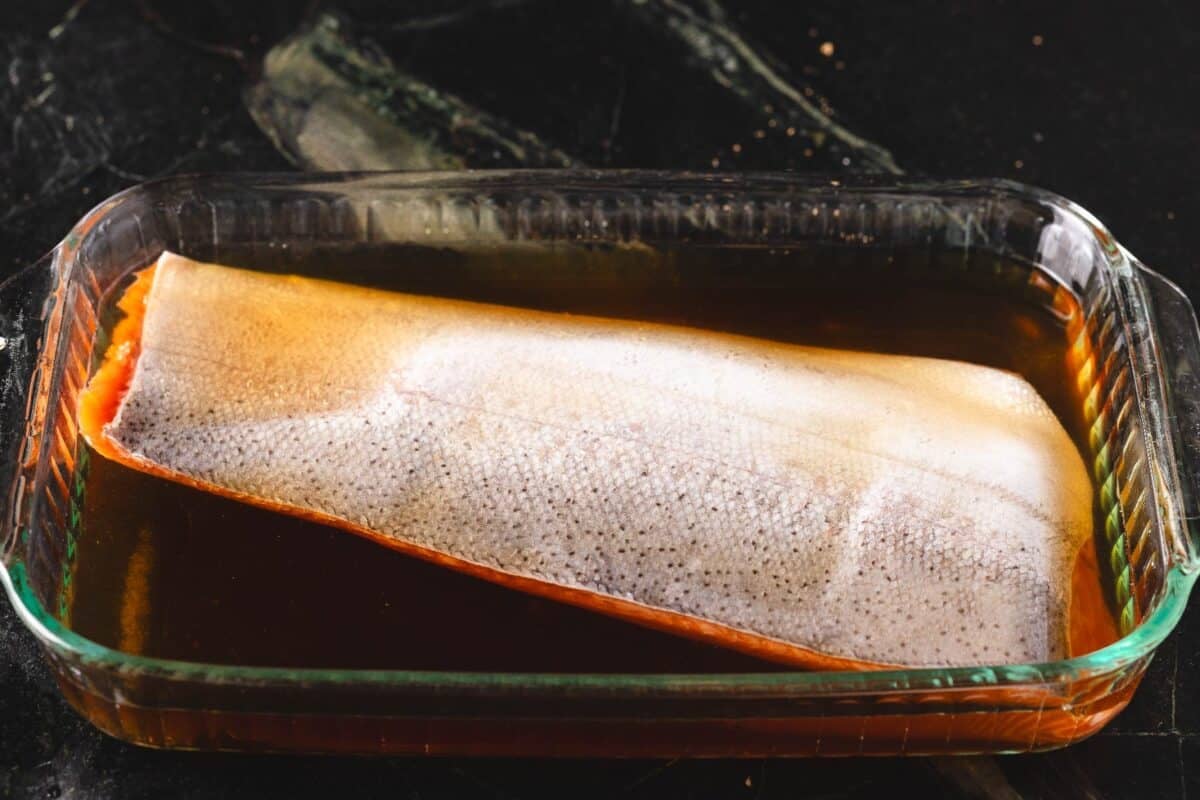
Glaze for Smoked Fish
I love adding a beautiful glaze to my trout during the final stage of smoking, but it does a lot more than just look good. My Maple Bourbon BBQ Glaze adds a sweet and savory finish that complements the smoky fish perfectly. By adding it with around 30 minutes to smoke, the glaze will also yield a slightly crispy, caramelized exterior. You can grab a bottle from the Hey Grill Hey Store, or whip up a batch using this recipe. If you don’t have any on hand, don’t worry. Your favorite BBQ sauce will work great, too. You can also skip the glaze entirely if you want to really enjoy the natural flavor of the fish.
How Long to Smoke Trout
An awesome thing about this steelhead trout is that it comes together on your smoker in right around 2 hours. If you’re glazing, you’ll be grilling in two phases. The first phase is all about getting that beautiful smoke flavor into the fish, and the second phase is where we add that gorgeous glaze for the final 30 minutes. Remember, these times are just guidelines. What you’re really looking for is that perfect internal temperature of 145 degrees F on a reliable meat thermometer.

How to Cook Steelhead Trout on the Smoker
Alright, it’s time for the fun. Follow these straightforward steps, and you’ll be making smoked steelhead trout like a real Backyard BBQ Hero:
- Make the brine. The salt and sugar need to fully dissolve so they can work evenly throughout the fish. A quick stir in a 9×13 baking dish is all it takes to get that brine ready for action.
- Preheat smoker. Keep it low and slow at 180 degrees F. This gentle heat lets the smoke really penetrate the fish while keeping it moist and tender.
- Brine trout. A quick 15-minute soak in the fridge is all it takes. This short brine helps the fish hold onto moisture without getting too salty.
- Smoke trout. Place that beautifully brined fillet skin-side down directly on the grates. This position helps protect the delicate flesh and makes it easier to remove once it’s done. The fish will start to take on a gorgeous brown color as it smokes.
- Glaze trout. When your fish hits about 125 degrees F, it’s glaze time. This timing gives the glaze just enough time to set up and caramelize without burning.
- Remove and serve. Once you hit that 145 degrees F internal temperature, you’re ready to impress your guests. A final drizzle of glaze adds that extra wow factor.
Serving Suggestions
This glazed steelhead trout makes an impressive main dish for any meal. It’s fancy enough for special occasions, but casual enough for a weeknight dinner with the family. I love serving it with some grilled vegetables, or you can flake it over a salad for a lighter option. If you’re feeling creative, you can even use it (minus the glaze) in my Smoked Trout Dip.
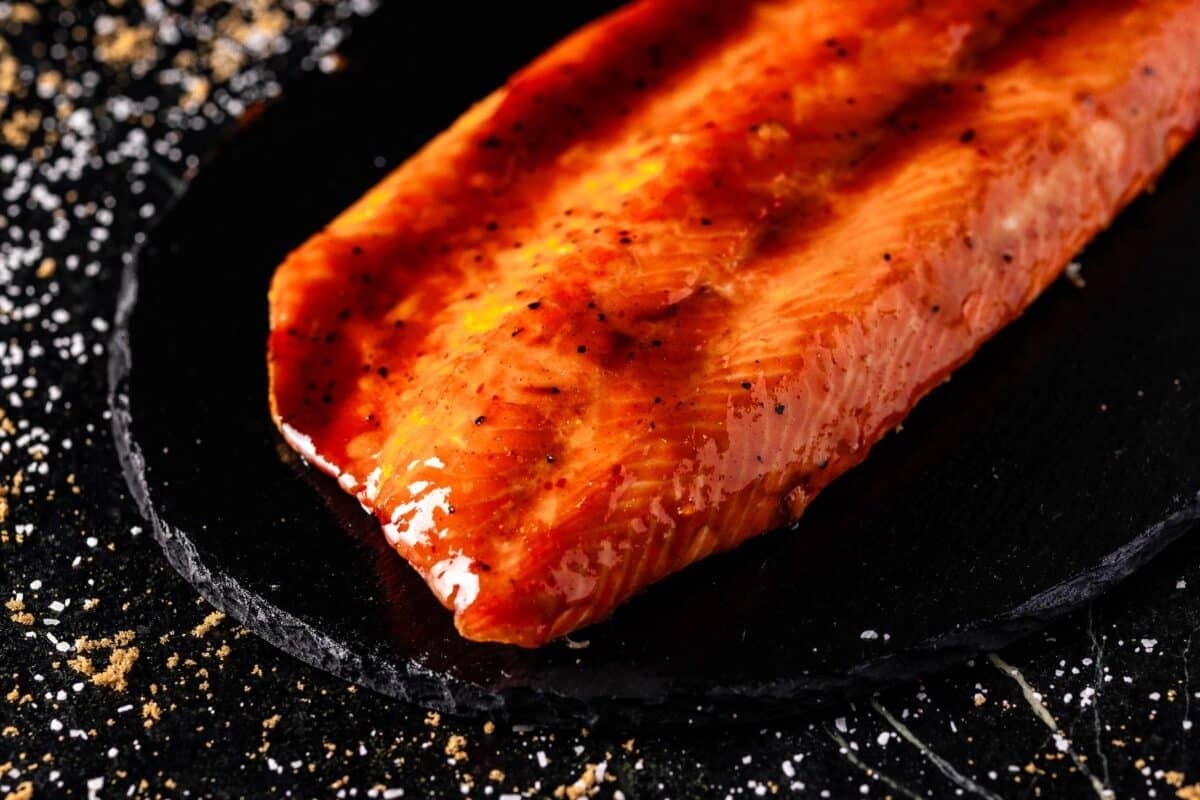
More Awesome BBQ fish Recipes
I’ve got over 700 BBQ recipes up my sleeve, and plenty of them are perfect for fish and seafood lovers. Each recipe comes with step-by-step instructions you can find in your Recipe Library or in the Hey Grill Hey App. For now, here are some of my favorites to try next:
Jerky
12+ Savory Jerky Recipes
If you’re looking for mouthwatering jerky recipes, this is the guide for you. From classic flavors to unique cuts, it’s…
Simple Smoked Steelhead Trout Recipe
I can’t wait to see your take on this Smoked Steelhead Trout recipe. Make sure to rate and comment below to let me know how it turned out. And, of course, don’t forget to share your smoky masterpieces with the Hey Grill Hey community. Just tag @heygrillhey on Facebook and Instagram.
For more yummy fish recipes and how-to videos, subscribe to my YouTube channel. If you’re looking to really take your BBQ game to the next level, head over to The Grill Squad. I’ve got courses to walk you through everything from buying your meat to using leftovers. No matter where you are on your journey to become a Backyard BBQ Hero, Hey Grill Hey is here to help.

Smoked Steelhead Trout with Maple Bourbon Glaze
Ingredients
- 1 steelhead trout fillet
- ¼ cup Maple Bourbon Glaze
Brown Sugar Brine
- 4 cups cool water
- 2 Tablespoons brown sugar
- 2 Tablespoons Kosher salt
Instructions
- Make the brine. Combine the ingredients for your brine in a 9×13 baking dish, and stir until the Kosher salt and brown sugar dissolve fully.4 cups cool water, 2 Tablespoons brown sugar, 2 Tablespoons Kosher salt
- Preheat smoker. Set your smoker for 180 degrees F for slow smoking.
- Brine trout. Place your trout in the brine, then place in your refrigerator to soak for around 15 minutes.1 steelhead trout fillet
- Smoke trout. Remove your trout from the brine and place it directly on your smoker grates with the skin down. Close the lid and smoke for 1 ½-2 hours, depending on the thickness of your fillet. When your salmon is about 30 minutes from done, move on to the next step.
- Glaze trout. When your trout reaches around 125 degrees F internal temperature, glaze with Maple Bourbon Glaze or your favorite BBQ sauce. Close the lid and continuing smoking another 30 minutes, or until your fish reaches an internal temperature of 145 degrees F. This step is optional but totally worth it.¼ cup Maple Bourbon Glaze
- Remove and serve. Transfer your smoked trout to a serving platter and drizzle with a little extra glaze. Serve immediately or chill, serve with your favorite accouterments, and enjoy.
Nutrition
Nutrition information is automatically calculated, so should only be used as an approximation.
